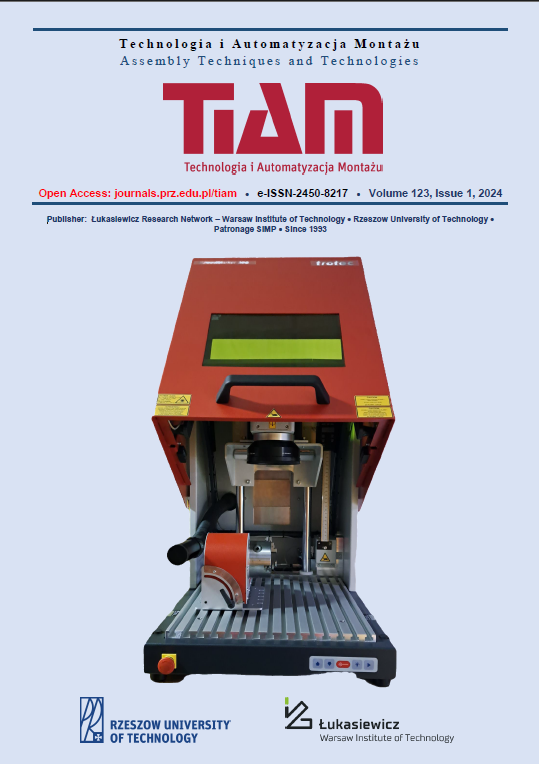Abstract
In today's highly competitive industrial environment, continuous improvement of efficiency and optimization of processes is crucial. This paper presents an approach to the optimization of conveyor systems that uses the concept of a digital shadow. A digital shadow, as an exact digital replica of a physical conveyor system, enables detailed simulation and analysis of real operational data, providing a basis for in-depth analysis and identification of areas for improvement. The aim of this approach is not only to improve the understanding of the dynamics and performance of existing conveyor systems, but also to increase the overall efficiency through predictive simulations and optimization algorithms. In this work, we demonstrate how the integration of a digital shadow into the simulation process can contribute to a better reaction to changes in the production environment, to the reduction of downtime and to the optimization of production flows. Our methodology combines data collection / analysis, and enables the creation of accurate and flexible models of conveyor systems. These models are then used in simulations that help identify optimal settings for different production scenarios and predict potential problems before they occur. The results of applying our approach on a test laboratory line show a significant improvement in efficiency and a reduction in operating costs. This study provides important insights and practical guidelines for engineers and production managers focused on the use of digital shadow to increase the efficiency of conveyor systems. It also contributes to the development of intelligent production technologies in the era of Industry 4.0.
References
Antosz K., Pasko L., Gola A, (2019) The Use of Intelligent Systems to Support the Decision-Making Process in Lean Maintenance Management, IFAC PapersOnLine 52-10, pp. 148-153. https://doi.org/10.1016/j.ifacol.2019.10.005
Graczyk-Tarasiuk, J., Karyono, K., & Karyono, K. (2022). The framework for the supplier qualification system for the world leader home appliances industry. Technologia I Automatyzacja Montażu (Assembly Techniques and Technologies), 116(2), 41-52. https://doi.org/10.7862/tiam.2022.2.6
Husar, J., Knapcikova, L., Balog, M. (2019). Implementation of Material Flow Simulation as a Learning Tool. In: Ivanov, V., et al. Advances in Design, Simulation and Manufacturing. DSMIE 2019. Lecture Notes in Mechanical Engineering. Springer, Cham. https://doi.org/10.1007/978-3-319-93587-4_4
Kassen, S., Tammen, H., Zarte, M., Pechmann, A. (2021) Concept and Case Study for a Generic Simulation as a Digital Shadow to Be Used for Production Optimisation. Processes, 9, 1362. https://doi.org/10.3390/pr9081362
Kawa, A., Fuks, K., Januszewski, P. (2016). Computer Simulation as a Research Method in Management Sciences, Studia Oeconomica Posnaniensia, no. 1, t. 4: 109-127.
Kluz, R., Antosz, K. (2019). Simulation of Fliexible Manufacturing Systems as an Element of Education Towards Industry 4,0. In: 6th International Scientific Technical Conference on Advances in Manufacturing II (Manufacturing): 332-341. https://doi.org/10.1007/978-3-030-18715-6_28.
Kolny, D., Kaczmar-Kolny, E., & Dulina, Ľuboslav. (2023). Modeling and simulation of the furniture manufacturing and assembly process in the arena simulation software . Technologia I Automatyzacja Montażu (Assembly Techniques and Technologies), 119(1), 13-22. https://doi.org/10.7862/tiam.2023.1.2
Kovbasiuk, K., Demčák, J., Husár, J., Hošovsky, A., Hladký, V. (2023). A Digital Twin for Remote Learning: A Case Study. In: Ivanov, V., Trojanowska, J., Pavlenko, I., Rauch, E., Piteľ, J. (eds) Advances in Design, Simulation and Manufacturing VI. DSMIE 2023. Lecture Notes in Mechanical Engineering. Springer, Cham. https://doi.org/10.1007/978-3-031-32767-4_36
Lazar, I., Husar, J. (2012). Validation of the serviceability of the manufacturing system using simulation. J. Effi. Responsib. Educ. Sci. 5(4), 252–261. https://doi.org/10.7160/eriesj.2012.050407
Li, Q., Hua, Qy., Feng, J., Niu, W., Wang, H., Zhong, J. (2011). Design and Implementation of Interactive Digital Shadow Simulation System. In: Ma, M. (eds) Communication Systems and Information Technology. Lecture Notes in Electrical Engineering, vol 100. Springer, Berlin, Heidelberg. https://doi.org/10.1007/978-3-642-21762-3_24
Malopolski, W., Wiercioch, A. (2018). An Approach to Modeling and Simulation of a Complex Conveyor System Using Delmia Quest—A Case Study. In: Hamrol, A., Ciszak, O., Legutko, S., Jurczyk, M. (eds) Advances in Manufacturing. Lecture Notes in Mechanical Engineering. Springer, Cham. https://doi.org/10.1007/978-3-319-68619-6_58
Mikušová, N., Stopka, O., Stopková, M. & Opettová, E. (2019). Use of simulation by modelling of conveyor belt contact forces. Open Engineering, 9(1), 709-715. https://doi.org/10.1515/eng-2019-0070
Pathak, S. D., Luitel, A., Singh, S. & Pandey, R. (2021) Second Generation Voltage Conveyor II based Shadow Filter, 2021 2nd International Conference for Emerging Technology (INCET), Belagavi, India, 2021, pp. 1-5, https://doi.org/10.1109/INCET51464.2021.9456370.
Răileanu, S., Borangiu, T., Ivănescu, N., Morariu, O. & Anton, F. (2020). Integrating the Digital Twin of a Shop Floor Conveyor in the Manufacturing Control System. In: Borangiu, T., Trentesaux, D., Leitão, P., Giret Boggino, A., Botti, V. (eds) Service Oriented, Holonic and Multi-agent Manufacturing Systems for Industry of the Future. SOHOMA 2019. Studies in Computational Intelligence, vol 853. Springer, Cham. https://doi.org/10.1007/978-3-030-27477-1_10
Ruzarovsky, R., Holubek, R., Delgado Sobrino, D. R., & Janíček, M. (2018). The Simulation of Conveyor Control System Using the Virtual Commissioning and Virtual Reality. Advances in Science and Technology Research Journal, 12(4), 164-171. https://doi.org/10.12913/22998624/100349
Salawu, G., Bright, G. & Onunka, Ch. (2020). Modelling and simulation of a conveyor belt system for optimal productivity, International Journal of Mechanical Engineering and Technology (IJMET), 11(1), pp. 115-121. https://doi.org/10.34218/IJMET.11.1.2020.012
Tri handoyo, I.., Subali, M. (2010). Conveyor control system based on high low at89s51 microcontroller-based products. pp.1-14.
Trojanowska, J., Husár, J., Hrehova, S. & Knapčíková, L. (2023) Poka Yoke in Smart Production Systems with Pick-to-Light Implementation to Increase Efficiency. Appl. Sci. 2023, 13, 11715. https://doi.org/10.3390/app132111715
Van Vianen, T., Ottjes, J. & Lodewijks, G. (2016) Belt conveyor network design using simulation. J Simulation 10, 157–165. https://doi.org/10.1057/jos.2014.38
Wang, T., Cheng, J., Yang, Y., Esposito, C., Snoussi, H. & Tao, F. (2022). Adaptive Optimization Method in Digital Twin Conveyor Systems via Range-Inspection Control, in IEEE Transactions on Automation Science and Engineering, 19 (2), pp. 1296-1304. https://doi.org/10.1109/TASE.2020.3043393.
Židek, K., Hladký, V., Pitel’, J., Demčák, J., Hošovský, A. & Lazorík, P. (2021). SMART Production System with Full Digitalization for Assembly and Inspection in Concept of Industry 4.0. In: Lecture Notes of the Institute for Computer Sciences, Social Informatics and Telecommunications Engineering, vol 382. Springer, Cham. https://doi.org/10.1007/978-3-030-78459-1_13


